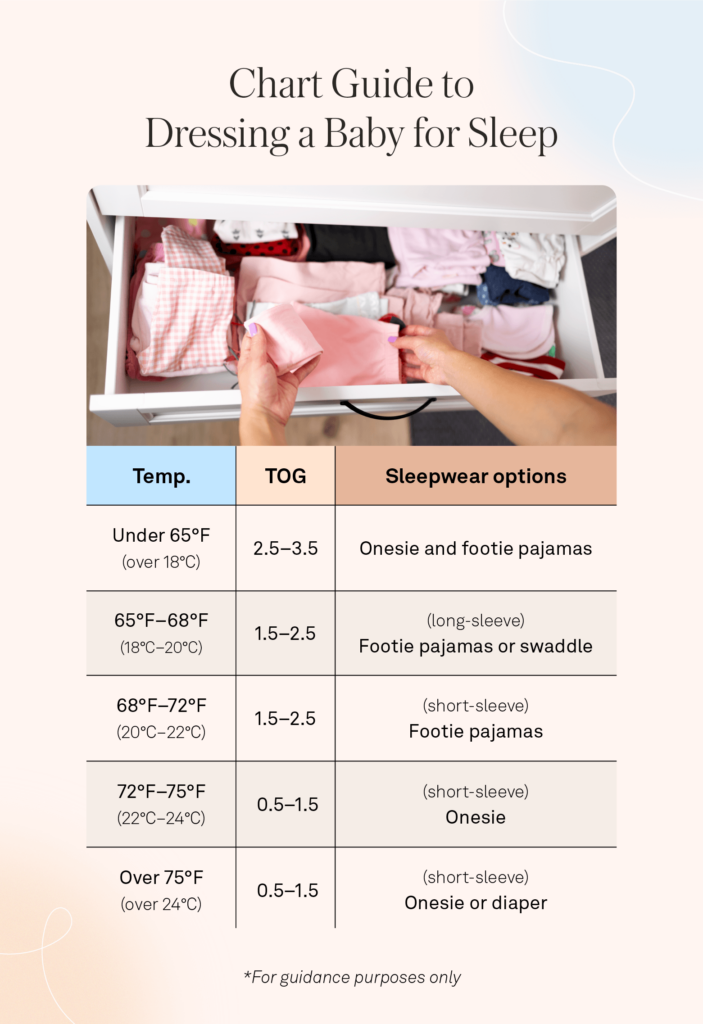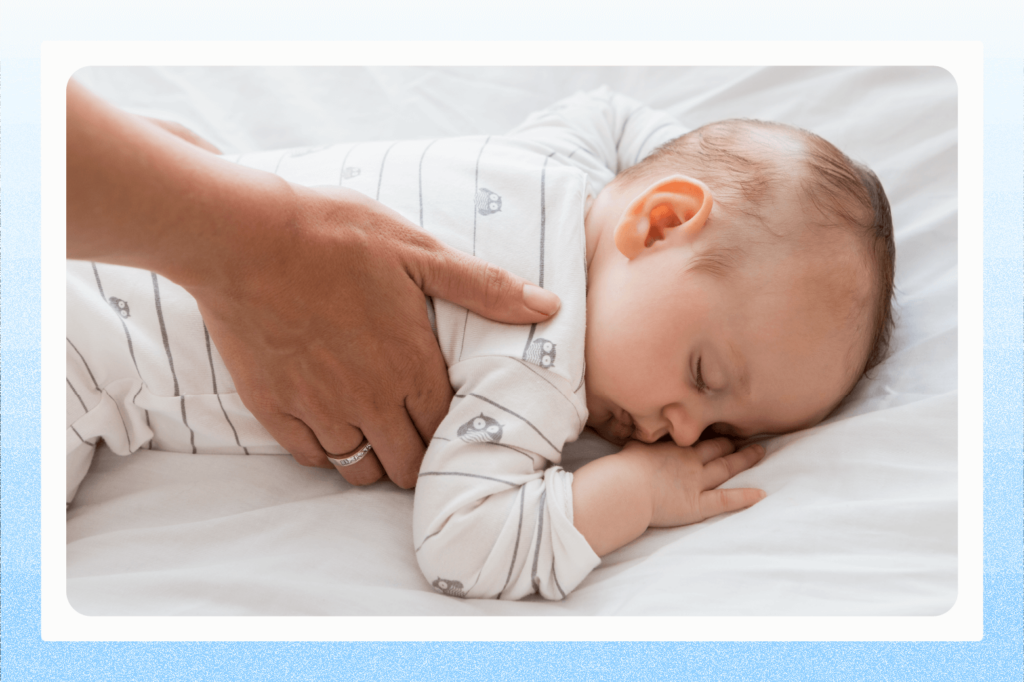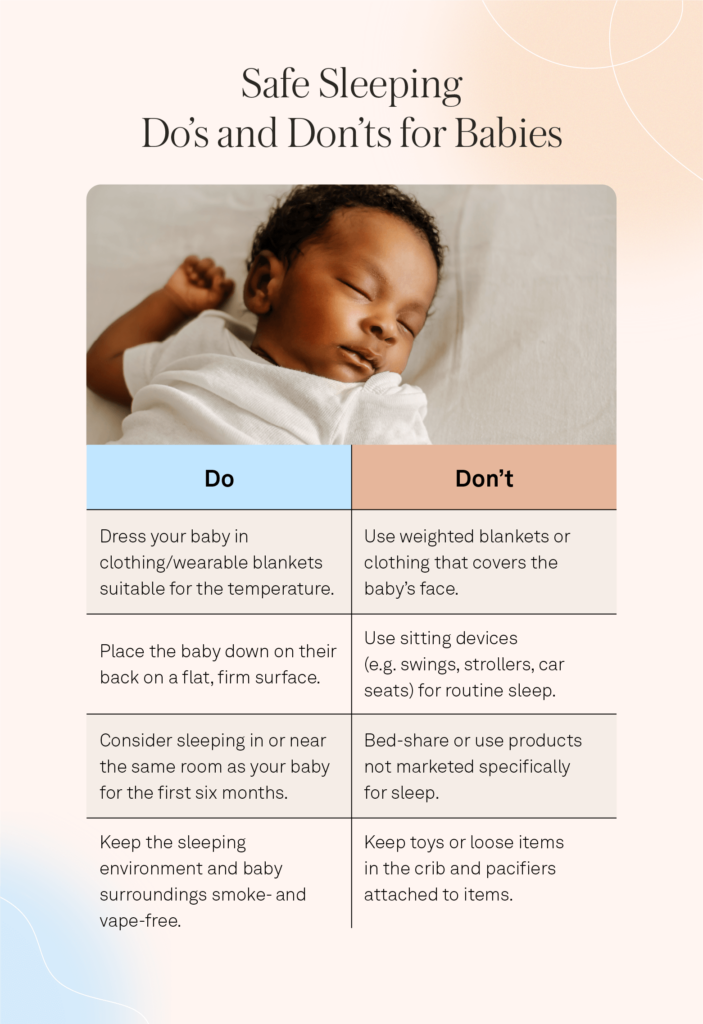From feeding schedules to planning activities around naptime, the first few months as a new parent can be quite the learning curve. Among these joyous responsibilities, deciding what your little one wears to sleep will also be essential to their care.
During the first few months of infancy, babies can’t regulate their body temperatures and can easily freeze or overheat. This vulnerability makes certain sleep attire and accessories potential health risks.
The key to keeping your baby safe and comfortable while asleep is choosing the best clothing options for their size and environment. In this guide, we’ll cover everything you need to know about how to dress your baby for sleep, as well as essential safety tips.
Best Room Temperature for a Sleeping Baby
Before selecting your baby’s sleepwear, first consider the room temperature. According to The Sleep Foundation, the recommended bedroom temperature for a sleeping baby is between 68 and 72 degrees Fahrenheit (20 to 22 degrees Celsius).
With this in mind, there isn’t a one-size-fits-all approach to sleeping spaces. All babies are unique, and the rooms of your home may feel different depending on where you live. A good rule of thumb is to assess the environment, asking yourself how you feel in the room and space. If you feel too hot or cold, your baby may also feel that way.
The ideal room temperature for your baby’s needs may change slightly as they age. Adjust the room temperature settings as needed to ensure your baby is comfortable.
How to Choose Sleepwear for Babies
When it comes to clothing, what your baby wears to sleep will help protect their sensitive body. Most sleep attire for babies comes with a thermal overall grade or “TOG” rating, which is a unit of measurement that describes the insulation of a garment. For babies, the general TOG rating ranges from 0.5 to 3.5.
Knowing the TOG rating of sleepwear can help you choose the best clothing options for your baby throughout the seasons. In the chart guide below, you’ll find recommendations for baby sleepwear based on their TOG ratings:

Warm seasons
For warm or summer nights, opt for breathable, lightweight fabrics such as cotton that allow air circulation. Try to avoid blankets, and instead, dress your baby in short-sleeve onesies or swaddles with a 1.0 TOG rating or lower.
Cool seasons
As for winter or cooler nights, layering for warmth is ideal. Opt for footed pajamas or one-piece sleeper sacks with 2.5 TOG ratings or higher for added insulation. It’s still best to avoid loose blankets, prioritizing wearable blankets instead.
How to Know Your Sleeping Baby Is Comfortable

Until babies are more mature and mobile, parents have to closely monitor them while asleep, making sure they’re not too hot or cold. The following signs are common indications your baby is uncomfortable and may need clothing adjustments:
- Crying or fussiness
- Faster, heavier breathing
- Flushed cheeks
- Damp, sweaty hair or neck
- Cool to the touch (when too cold)
Be mindful of thick clothing material and blankets, which can cause accidental suffocation and overheating. Also, avoid clothing with loose strings and accessories, which can increase the risk of choking. These types of garments pose a risk to sleeping infants.
Dressing your baby with layers
Layering sleepwear can also make it easier to adjust to your sleeping baby’s needs. For example, if your baby starts to feel warmer or colder during the night, you can add or remove garments as needed. Pajamas with snap buttons or zippers offer easy accessibility and more convenient layer options.
Dressing your baby in layers can be just as helpful during the daytime, too. Infants typically sleep an average of 14 hours within a 24-hour period, so the room temperature will feel different throughout the day, just as it will at night.
Sleep Safety Tips for Babies
Practicing safe sleeping habits for your baby can help protect them from hazards such as overheating, choking, and suffocation, all of which can increase the risk of sudden infant death syndrome (SIDS). Minding the following factors will help keep your sleeping baby both safe and comfortable:
- Room temperature: Aim for 68℉ to 72℉ (20℃ to 22℃) and adjust your baby’s clothing or layers as needed.
- Location: Have your baby sleep in a clutter-free crib or bassinet with a firm mattress in or near your bedroom for easy monitoring.
- Considerations: Place your baby to sleep on their back with no loose blankets or accessories for them to grab.
In addition to the tips above, we’ve created a chart rounding up the top sleep safety recommendations from the American Academy of Pediatrics (AAP) to reduce the risk of SIDs and other hazards.

FAQ on Dressing Babies for Sleep
Is it safe to swaddle a baby at night?
Swaddling — wrapping babies in swaddle garments for sleeping — is a safe sleeping option for newborns. When done correctly, swaddling can remind infants of the womb and help both calm and promote sleep. For optimal safety, only place a swaddled baby on their back for sleep. It’s recommended to stop swaddling once the baby can roll themself over.
How do I know if my baby is cold at night?
Babies that feel cold are more likely to cry and wake up frequently. They may also appear shivering, and their skin feels cold to the touch. An effective way to find out if your baby is cold or hot is to check their chest or back of their neck.
Can a baby sleep in just a onesie?
Yes, at and above room temperature, your baby may wear just a onesie if that makes them comfortable. However, it’s important to assess the room and dress your baby in an additional, lightweight layer that is easy to remove when needed.
Dressing a baby for sleep is one of many learning experiences for new parents. Remember, when it comes to proper sleep attire for babies, comfort and safety are what matter. And don’t rely on the thermostat alone — always assess the sleep environment first to ensure it’s comfortable for your baby.
Now that you know how to dress babies for sleep, adding options to your baby registry checklist will be a breeze. Use Joy’s Baby Registry to easily find and choose the best sleepwear from top-name brands you know and love.
